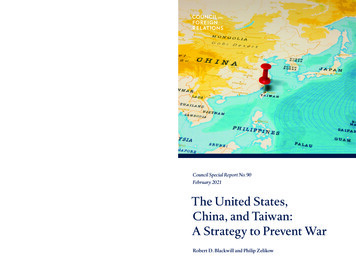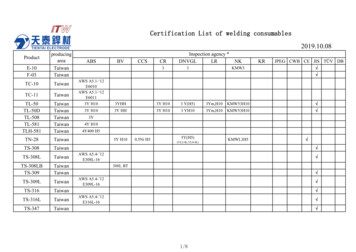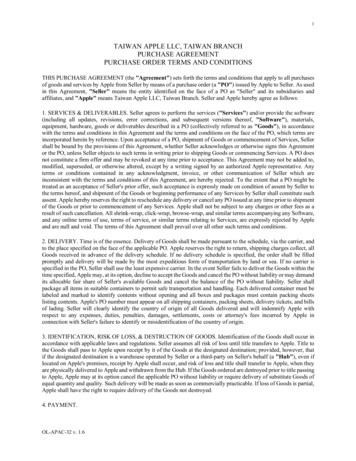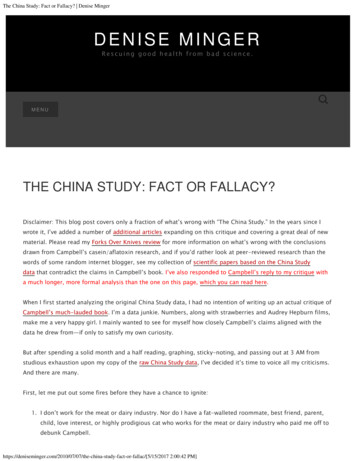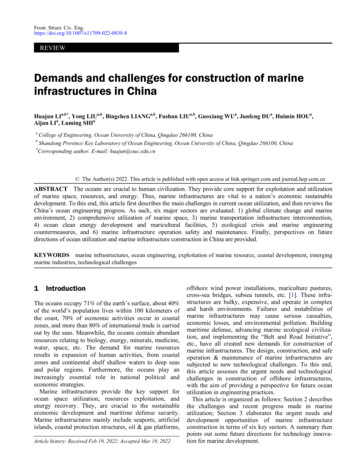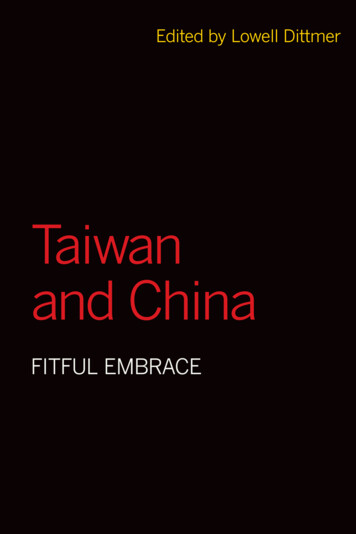
Transcription
Edited by Lowell DittmerTaiwanand ChinaFITFUL EMBRACE
Luminos is the Open Access monograph publishing program fromUC Press. Luminos provides a framework for preserving and reinvigorating monograph publishing for the future and increases thereach and visibility of important scholarly work. Titles publishedin the UC Press Luminos model are published with the same highstandards for selection, peer review, production, and marketing asthose in our traditional program. www.luminosoa.org
The publisher gratefully acknowledges the generous support of theSue Tsao Endowment Fund in Chinese Studies of the University ofCalifornia Press Foundation.
Taiwan and China
Taiwan and ChinaFitful EmbraceEdited byLowell DittmerUNIVERSIT Y OF CALIFORNIA PRESS
University of California Press, one of the most distinguished universitypresses in the United States, enriches lives around the world by advancing scholarship in the humanities, social sciences, and natural sciences. Itsactivities are supported by the UC Press Foundation and by philanthropiccontributions from individuals and institutions. For more information,visit www.ucpress.edu.University of California PressOakland, California 2017 by Lowell DittmerSuggested citation: Dittmer, Lowell (ed.). Taiwan and China: FitfulEmbrace. Oakland: University of California Press, 2017. doi: https://doi.org/10.1525/luminos.38This work is licensed under a Creative Commons CC-BY-NC-ND license.To view a copy of the license, visit http://creativecommons.org/licenses.Library of Congress Cataloging-in-Publication DataNames: Dittmer, Lowell, editor.Title: Taiwan and China : fitful embrace / edited by Lowell Dittmer.Description: Oakland, California : University of California Press, [2017] Includes bibliographical references and index. Identifiers: LCCN 2017016677 (print) LCCN 2017019352 (ebook) ISBN9780520968707 (ebook) ISBN 9780520295988 (pbk. : alk. paper)Subjects: LCSH: Taiwan—Relations—China. China—Relations—Taiwan. Chinese reunification question, 1949- Taiwan--Politics andgovernment—21st century. China--Politics and government—21st century.Classification: LCC DS799.63.C6 (ebook) LCC DS799.63.C6 T25 2017 (print) DDC 327.51051249--dc23LC record available at 432019211817
C onte ntsList of Abbreviations vii1. IntroductionLowell Dittmer 1Part I. National Identity2. Taiwan’s National Identity and Cross-Strait RelationsYi-huah Jiang 193. Changing Identities in Taiwan under Ma Ying-jeouJean-Pierre Cabestan 424. Mingling but Not Merging: Changes and Continuities in theIdentity of Taiwanese in Mainland ChinaShu Keng and Emmy Ruihua Lin 615. Chinese National Identity under ReconstructionGang Lin and Weixu Wu 756. Chinese Youth Nationalism in a Pressure CookerRou-lan Chen 93
vi ContentsPart II. Political Economy7. Varieties of State Capitalism across the Taiwan Strait:A Comparison and Its ImplicationsChih-shian Liou 1178. The Nature and Trend of Taiwanese Investment in China (1991–2014):Business Orientation, Profit Seeking, and DepoliticizationChung-min Tsai 1339. Cross-Strait Economic Relations and China’s Rise:The Case of the IT SectorTse-Kang Leng 15110. Social Entrepreneurialism and Social Media in Post–developmentalstate TaiwanYou-tien Hsing 175Part III. Political Strategy11. Pivot, Hedger, or Partner: Strategies of Lesser Powers Caughtbetween HegemonsYu-Shan Wu 19712. A Farewell to Arms? US Security Relations with Taiwan and theProspects for Stability in the Taiwan StraitPing-Kuei Chen, Scott L. Kastner, and William L. Reed 22113. Xi Jinping’s Taiwan Policy: Boxing Taiwan In with theOne-China FrameworkJing Huang 23914. Strategies of China’s Expansion and Taiwan’s Survival inSoutheast Asia: A Comparative PerspectiveSamuel C. Y. Ku 249IV. Conclusion15. Taiwan and the Waning Dream of ReunificationLowell Dittmer 283List of Contributors 301Index 305
Abbreviati onsACCASEAN-China CenterAFTAASEAN-China Free Trade AreaAIIBAsian Infrastructure Investment BankANZTEC Agreement between New Zealand and the Separate Customs Territory of Taiwan, Penghu, Kinmen and Matsu on Economic CooperationAPECAsia Pacific Economic CooperationAPROCAsia-Pacific Regional Operations CenterARATSAssociation for Relations Across the Taiwan StraitsARFASEAN Regional ForumASEANAssociation of Southeast Asian NationsASLAnti-Secession LawASTEP Agreement between Singapore and the Separate Customs Territoryof Taiwan, Penghu, Kinmen and Matsu on Economic PartnershipA2ADAnti-Access Area DenialBFABoao Forum for AsiaBOPbalance-of-powerCAFTAChina-ASEAN Free Trade AgreementCCPChinese Communist PartyCOCCode of Conduct in the South China SeaCPCCCChinese People’s Political Consultative ConferenceCSTACross-Strait Service Trade AgreementDOCDeclaration on the Conduct of Parties in the South China SeaDPPDemocratic Progressive Partyvii
viii ITRIKMTMIRVOBMOBORODMOEMPAPP3 TFT-LCDTPPTPTSTSMCEast Asia SummitEconomic Cooperation Framework Agreementforeign direct investmentforeign-invested enterpriseFree Economic Pilot Zonefree trade agreementGreater Mekong Subregionintegrated circuitintercontinental ballistic missileinformation and communications technologyInternational Monetary Fundinternational relationsIndustry Technology Research InstituteKuomintangmultiple independently retargeted vehicleown-brand manufactureOne Belt, One Roadoriginal design manufactureoriginal equipment manufacturePeople’s Action Party (Singapore)Pacific Three Closer Economic PartnershipTrans-Pacific Strategic Economic Partnership (aka TPSEP)People’s Liberation ArmyPeople’s Republic of ChinaRegional Comprehensive Economic PartnershiprenminbiRepublic of ChinaState-Owned Assets Supervision and Administration CommissionStraits Exchange Foundationsubmarine-launched missilesmall and medium enterprisesstate-owned enterpriseSilicon Precision Industries Co.Treaty of Amity and Cooperation in Southeast AsiaTaiwan Affairs Officethin-film-transistor liquid-crystal-displayTrans-Pacific PartnershipTaiwan Public Television ServiceTaiwan Semiconductor Manufacturing Company
1IntroductionLowell DittmerChina’s contentious relation to Taiwan began when the People’s Republic of China(PRC) was founded in October 1949 and the defeated Kuomintang (KMT) set upan exile regime on the island two months later. Without now delving into the richlegal and historical complexities, suffice it to say that the island’s autonomous sovereignty has been in contention ever since, initially because of the KMT’s stubborninsistence that it continued to represent not just Taiwan but all of China, and later,when the tables had turned, because Taiwan refused to cede sovereignty to thenow dominant power that had arisen on the other side of the Strait. At this writing, the election of a Democratic Progressive Party (DPP) government under TsaiIng-wen in January 2016 brings the island to a new inflection point. For, like theChen Shui-bian administration in 2000–2008, the incoming DPP regime wouldreally prefer to drop all claim to be part of the Chinese mainland and to embracepolitical independence. Of course they dare not say this in so many words becauseit would infuriate Beijing, which continues to insist that there is one China, thatTaiwan is a part of it, and that any assertion otherwise by Taiwan constitutes an illegal attempt at secession that Beijing has the legal right to prevent by force. Chinawould prefer that contingency not to arise. Its use of force against Taiwan wouldresult in great damage to the lives and property of people with whom mainlanders share a Chinese ancestry (compatriots in an ethnic or cultural sense, tongbao)whom the PRC aims to return to the motherland’s embrace and possibly to themainland as well. Chinese military forces still respect the striking power of Taiwan’s armed forces and wish to avoid the possibility of US intervention to defendthe island’s sovereignty (even though the United States no longer formally recognizes that sovereignty). Such escalation could well cause great harm to China, to1
2 Chapter OneTaiwan, and indeed to the United States. In other words, the Taiwan Strait remainsan international flash point, one of the few places in the world that could unleashwar between two great powers, both of which are nuclear weapon states.But one of the things that makes Taiwan so politically difficult and so intellectually fascinating is that it poses not merely a security problem but a nexus of interrelated puzzles. The following chapters focus in turn on three of its aspects. The first is“national identity.” This is a problem that Taiwan should not be permitted to have,according to mainland critics, because it is not even a nation. Yet Taiwanese doshare a sense of collective identity that is widely perceived there as distinct, whichthey seek to preserve and profess to be willing to fight for. This has greatly complicated Beijing’s quest to promote reunification, particularly after the post-1979 shiftfrom a focus on “armed liberation” to a focus on peaceful reunion, for to be peaceful it must also be voluntary. The second aspect of the problem is socioeconomic.The post-1979 shift to peaceful reunification was premised on the assumption thatthrough “three direct links”—postal, transportation, and trade—the embitteredgulf dividing the two peoples at the Strait could eventually be bridged. While the“three links” met with an immediate “three nos” (no contact, no compromise, nonegotiation) from the Chiang Ching-kuo regime, Beijing nevertheless perseveredby accommodating “three indirect links” (mainly via Hong Kong), and these informal connections, unsuccessfully repressed but ultimately tolerated by the Taiwanauthorities, have proved surprisingly robust, paving the way for their formalizationin 2008. Yet communication has not exactly blossomed into fraternal love. Thethird dimension of the problem is political-strategic. This has both national andinternational aspects. Nationally, what do China and Taiwan expect of their futurerelationship—what adjustments will each demand of the other in terms of structural political changes, or what nonchanges will each tolerate—and how do they planto effect such changes? Internationally, how will reunification be achieved—or, howcan Taiwan’s autonomy be preserved—in the prevailing balance of power, and whatimpact will either outcome have on that balance?NAT IO NA L I D E N T I T YA sense of national identity has long been conceived by political scientists to bea vital part of nation building, as it instills loyalty and participatory zeal in anethnoreligiously heterogeneous citizenry and a sense of collective coherence andinternational affiliation or direction in the nation-state. At the same time, in extreme cases it can drive blind and ultimately self-destructive international ambitions. The Chinese sense of identity with regard to Taiwan and other peripheralregions has been fairly stable, even spanning both Nationalist and communistrevolutionary eras: the understanding is that all of these areas should be assimilated into the motherland as soon and as fully as possible, making minimal
Introduction 3allowance for ethnolinguistic differences.1 In contrast, the sense of nationalidentity in Taiwan has varied greatly over time, recurrently tending to destabilize the relationship. Taiwan attained provincial status in the Qing Empire onlyten years before being forfeited to Japan as part of the Shimonoseki peace settlement at the end of the first Sino-Japanese War in 1895, thenceforth remaining aJapanese colony for the next fifty years. Upon occupying the island after 1945, theNationalist forces reintroduced a Chinese identity for it, initially as a backwardoutpost of the lost republic but after loss of the civil war as temporary capital of agovernment in exile. While there had been resistance to the Japanese occupationregime, it seems to have been less than in the contemporaneous Korean colony,and postcolonial Taiwan has also remained friendlier to Japan than either Southor North Korea, affiliating Taiwan during the Cold War into a US-Japan-Taiwansecurity network. All these identity adjustments were superimposed from thetop down on a relatively passive populace.With the introduction of democracy in the twilight years of the Chiangs’ reignat the end of the 1980s, the evolution of national identity on the island was stimulated by diverse impulses, including a scrambled international scene at the end ofthe Cold War, an attractive offer for peaceful reunification from the mainland, andthe aspirations of the newly enfranchised Taiwanese electorate. As Yi-huah Jiang,former premier of the Republic of China and professor of political science at Taiwan University, indicates in chapter 2 of this volume, the overall thrust of Taiwan’sevolving identity tended to be “modernist.” Drawing on the pattern-variable distinction between ascribed and achieved identities, he shows how the primordialdivision, a “subethnic” split between original inhabitants of the island (benshengren) and the wave of Chinese who fled the mainland at the end of the civil war(waishengren), has gradually faded over time. This is evinced not only in the growing number of citizens who answer the survey question “I am” with “Taiwanese”(as opposed to “Chinese” or “both”) but in more refined survey instruments of hisown devising that measure identity in terms of various constructed variables. Andthis corresponds with a “future nation preference” shifting ever more toward independence and away from any interest in reunification. All this is quite contrary tothe preferences of the mainland, of course, which is thereby incentivized to reconsider its option to resort to force if Taiwan moves toward formal independence.Yet ironically Jiang finds that while majority preferences have shifted toward independence they are not strongly held: only a small percentage would still pursueindependence in the face of a credible threat of force. The Taiwanese electorate ispragmatic, willing to subordinate ideal preferences to political survival. Hence theconsistent majority preference for “no independence, no reunification” (bu du butong). In view of the fairly invariant attachment to a cross-Strait status quo, Jiangargues that the more relevant issue is not identity but the interpretation of “oneChina.” If the PRC and ROC agree that, despite the existence of two governments
4 Chapter Onethat claim to be “China,” there is only one China in the world, who is its legitimaterepresentative, and what repercussions do differing interpretations of “one China”have for policy and diplomacy? In other words, the essential question is one ofsovereignty: Who rules?In chapter 3, one of the few extant studies of the evolution of national identityin Taiwan during the Ma Ying-jeou era, Jean-Pierre Cabestan arrives at the rather startling finding that despite a landslide victory for this Nationalist presidentin 2008, followed by rapid and successful moves toward reconciliation with themainland, the Taiwan electorate’s interest in reunification has only waned. Andthis, he argues, is not because the “Blue” camp (a coalition of parties, most predominantly the KMT and the People First Party, that takes a softer position towardthe PRC, supporting a reunification that is often envisioned as long-deferred andas dependent on the PRC’s fulfillment of many conditions, as well as an increasein ties with the mainland) simply avoided an unpopular issue. To the contrary, theNationalists made a concerted drive during their eight-year control of both executive and legislative branches to reverse the DPP’s foregoing “de-Sinification” movement and restore faith in “one China,” interpreted as the Republic of China (ROC)on Taiwan. Cross-Strait trade and investment increased, regular discussions wereresumed between the Taiwan’s Straits Exchange Foundation (SEF) and China’s Association for Relations Across the Taiwan Straits (ARATS), resulting in some twodozen agreements, most prominently the “three direct links” and the 2010 Economic Cooperation Framework Agreement (ECFA), and mainland tourism andinvestment in the island was for the first time permitted. Having already passeda law against “secession,” Beijing downplayed its invasion threats and agreed andadhered to a diplomatic truce, permitting Taiwan to make trade agreements withNew Zealand and Singapore that it could have blocked and to participate informally in the World Health Association. The mainland authorities even agreed tonegotiate cultural exchanges and some form of peace treaty with the island. Butafter initially expressing interest the Ma leadership opted not to pursue these. Andthe attempt to move ahead toward further economic integration in a Cross-StraitService Trade Agreement (CSTA), after being bilaterally agreed on, was blocked inthe Legislative Yuan, where the KMT held a commanding majority.The PRC authorities must have been quite perplexed that a relationship theyhad so carefully nurtured and that seemed to be making excellent economic progress could so swiftly unravel. How could this be? Cabestan points to a number ofunnoticed flaws with cross-Strait détente. First and foremost, increasing economiclinkages with the mainland did not prove to be quite the panacea that had beenadvertised. Exports constitute about 70 percent of Taiwan’s GDP, some 40 percentof which go to China or Hong Kong. But PRC growth has been decelerating since2010 for a number of reasons, none of which have much to do with Taiwan, norhave the island’s other trade partners made a very impressive recovery from the
Introduction 5global financial crisis, so export growth stalled. There is a perception (only weaklysupported by available evidence) that the growth that has occurred has been moreunequally distributed (to businesses with mainland investments) than before. Theeconomic “gifts” bestowed by the PRC, such as “early harvest” post-ECFA trade arrangements, tend to be discounted in Taiwan for having ulterior political motives(which China has never denied). The student-led, anti-CSTA “Sunflower Movement” that occupied the legislature several weeks in the spring of 2014 seems tohave been surprisingly successful in mobilizing mass support, especially amongthe young people ironically most likely to seek jobs on the mainland. It seemsthat the more economic integration succeeds, the greater the tendency to mobilizenational identity as a counterweight.Chapter 4, by Shu Keng and Emmy Ruihua Lin of the Shanghai University ofFinance and Economics, takes on one of the key pieces of this puzzle, namely thepolitical opinions of the growing number (currently estimated at over a million)of Taiwanese businesspeople or taishang who move to the mainland on a more orless permanent basis to pursue their livelihoods. On the basis of an extensive (452respondents) survey of Taiwan sojourners in Dongguan and the Shanghai region,Keng and Lin indeed find many changes: these Taiwanese are happy to assimilateto mainland culture, to marry Chinese spouses and have children, and to set uptheir own business associations, even schools. Their attitudes toward the mainland do change as well: they are more likely to vote “Blue,” less likely to endorseTaiwan independence (the percentage sinks drastically, from 25.8 percent to 3.5percent), and more likely to be open to future reunification (the percentage morethan doubles, from 9.9 percent to 21.4 percent). The puzzle is that despite all theseadaptations they are not inclined to give up their Taiwanese identity. They evencontinue to prefer independence to reunification, by a wide (if reduced) margin.Why? Keng and Lin attribute the resilience of Taiwan identities to taishang mobility: because they can quickly and easily return, they continue to view Taiwan as“home.” There may be other answers as well to this underresearched and methodologically elusive question. Class may be a factor—living standards remain muchhigher in Taiwan than on the mainland (even though sojourners typically stilldraw Taiwanese salaries). And sojourners tend to limit their assimilation, forming their own clubs, social networks, schools, and communities on the mainland.Finally, politics—though ideology is played down, and Taiwan’s democracy is oftenderided in China as chaotic and corrupt—may play a role. It may take generations(e.g., children of Taiwan-Chinese marriages) for full identity convergence to occur.The Chinese insist that the mainland population should also have a voice inthe future of Taiwan, and although this is often disputed on the island, in view ofthe PRC’s looming economic and military power it seems inevitable that it will. Inchapter 5, Gang Lin of Shanghai Jiaotong University and Weixu Wu of TsinghuaUniversity bring a perceptive Chinese perspective to the issue. Understandably,
6 Chapter Onewhile Taiwanese intellectuals tend to focus on national identity as “constructed,”the mainland preference is to view it as primordial—as Chinese president Xi Jinping put it in his 2015 Singapore meeting with Ma Ying-jeou, “No force can pullus apart because we are brothers who are still connected by our flesh even if ourbones are broken, we are a family in which blood is thicker than water.” Mainlanders invoke a shared culture, again viewed not as malleable but as primordial: thepath-dependent culture laid down by Confucianism, which the People’s Republicnow honors along with Taiwan. The future is also evoked as a sentimental basis fortogetherness: the two peoples constitute a “community of cross-Strait shared destinies.” The complex issue of institutional integration (i.e., mutual structural adjustments) is postponed with the “one country, two systems” formula that assuresTaiwan even more latitude than Hong Kong’s Special Administrative Region forthe next fifty years. Successful integration of taishang into mainland society supposedly illustrates the potential for integration without institutional convergence.At the same time Chinese tacitly concede the weakness of their approach, notingthat civil identity has fallen behind ethnic identity as a force for reunification. Thepossibility that the People’s Democracy might at some future point usefully emulate Taiwan-style structural reforms is rarely entertained (and never officially).Mainland views of the Taiwan issue are difficult to research because publicopinion polling on that sensitive topic is not permitted, no doubt because Beijing’shopes for peaceful reunification could well be derailed by an outburst of Chinesenationalism. In chapter 6, Rou-lan Chen thus tackles the even more volatile butstill uncensored issue of the Senkaku Islands, known in Taiwan (to which they areclosest, some 43.5 miles away) as Diaoyu Tai and on the mainland as Diaoyu Dao.Japan surveyed the eight tiny uninhabited islets, declared them terra nullius, andannexed them under the jurisdiction of Okinawa prefecture in 1895; ever sincetheir occupation by the United States from 1945 to 1971 they have been under Japanese control. Since the discovery of potential subsurface hydrocarbon deposits inthe area in 1968, Japanese sovereignty has been disputed by both Taiwan and thePRC. Beijing’s claim to the islets is subsidiary to its claim to Taiwan, as it contends(despite Tokyo’s claims to the contrary) that they were part of the “unequal” Shimonoseki treaty ceding Taiwan to Japan. Although the islets are also claimed byTaiwan (much to China’s satisfaction), their parallel provenance and proximitymake them a politically accessible synecdoche for China’s claim to Taiwan, andas such a polemical target of China’s nationalistic “raging youth” (fen qing). Chenanalyzes this politically articulate subsection of Chinese civil society through asample of over a thousand contributions to a quasi-official Internet bulletin boardcalled the Strong Nation Forum. In a fascinating psycho-political analysis ofthese data, she finds that the outraged nationalism provoked by the issue symptomizes deep ambivalence in China’s younger generation. Their rage is directedpartly against Japan, for claiming property that rightfully belongs to China, but
Introduction 7also against the Chinese Communist Party (CCP) leadership for responding withsuch weakness and timidity to this violation of national sovereignty. This sense ofnationalist outrage, which has upon occasion taken the form of mass demonstrations and even collective vandalism, may be traced to the massive expansion ofthe education system since 1999, the decay of established institutions of collective identity (e.g., the Communist Youth League), rising expectations after severaldecades of double-digit growth, and limited job opportunities for young people.Whatever the socioeconomic reagents, it seems to be a recurrent pattern of explosive youthful activism.P O L I T IC A L E C O N OM YIn chapter 7, Chih-shian Liou begins our discussion of political economic connections with a comparative analysis of state-owned enterprise (SOE) in Chinaand Taiwan. As an isomorphic component of Leninist “commanding heights”state-led developmentalism on both sides of the Strait, the SOE provides a useful point of departure. Though SOEs in China and Taiwan have the same origin,they have since undergone diverging trajectories. In the PRC they have beenideologically identified with socialism and thus favored with subsidies, preferredbank loan terms, merger and acquisition opportunities, initial public offerings,and stock market listings, and, in a number of “pillar” or strategic industries,they have been protected from market competition. Though subject to a series ofreforms since the 1990s, SOEs continue to enjoy de facto soft budget constraints,while the directors are appointed by the Organization Department of the CCPCentral Committee and have ministerial rank. The state has tried to make SOEs“national champions” able to compete with multinational corporations globally,thanks to which the second- and third-largest corporations in the world (Sinopec and China National Petroleum Corporation, respectively) are both SOEs.Though SOEs in 1978 made up three-quarters of China’s GDP and have shriveledto only about one-quarter of that today, they are likely to remain in a privilegedupstream industrial position under CCP control. In Taiwan, on the other hand,while SOEs played a key role in the early industrialization stage, privatizationpolicy was introduced in the late 1980s. Thus, while SOEs accounted for 35.2percent of capital formation in 1961, by 2001 they accounted for only about 9percent. In contradistinction to Japan, South Korea, and China, Taiwan’s growthhas been led by small and medium enterprises (SMEs), usually family controlled.The pioneering dimension of Liou’s analysis relates this comparative analysis tothe dynamics of cross-Strait economic relations. Depending on the ideologicalemphasis at the time, SOEs are politically preferred to foreign-invested enterprises (FIEs), and this will tend to crowd out Taiwan-invested capital on themainland. Growing cross-Strait economic interdependence, Liou points out,
8 Chapter Onealso raises the issue of trade externality: “In general trade among allies generatesa positive security externality while trade among nonallies generates a negativesecurity externality.” Finally, there is the issue of economic asymmetry: the proportion of Chinese trade with Taiwan is much smaller than the proportion ofTaiwan’s trade with China (over 30 percent), meaning Taiwan is more dependenton China than vice versa. To deepen bilateral economic integration the mainlandhas consistently permitted an imbalance of payments very much in Taiwan’s favor, also making the China-Taiwan trade relations more valuable to Taiwan thanto the PRC.Chapter 8, by Chung-min Tsai of National Cheng Chi University, focusessquarely on cross-Strait trade and investment and its impact on politics. Trade andinvestment, he finds, have increased inexorably over time, giving rise to Chineseconfidence that economic integration must eventually lead, in accordance withneofunctional (and Marxist) logic, to political integration. In Taiwan’s case, tradewas soon followed by investment, and as investment increased it pulled in relatedtrade. There were four big waves of Taiwan investment in China: (1) in the late1980s, after the appreciation of Taiwan’s currency priced Taiwan out of Americanmarkets and the government removed constraints on capital outflow; (2) 1992–94,after Deng’s “southern voyage” inaugurating a new wave of liberal economic reform and coinciding with the Singapore talks; (3) in the early 2000s, during theworld high-tech recession, when Taiwan’s computer industry moved to the mainland to remain price competitive; and (4) post-2010, following the signing of theECFA with its “early harvest” enticements. As the connection thrived, Taiwancapital has moved from labor-intensive assembly to high-tech production, fromsouth to north and from east to west, from a more general export orientation toa focus on the China market. What is perhaps surprising is that the nexus between economics and politics has certainly not gone unnoticed in Taiwan, andpoliticians opposed to unification, such as Lee Teng-hui and Chen Shui-bian, havetaken steps to arrest its development.And what has been the impact of politics on economic integration? Attemptsunder Lee Teng-hui’s presidency to “go slow” (jieji yongren) on investment in themainland and divert it to Southeast Asia may have had some temporary impactin the wake of the 1995–96 missile crisis. But the Asian financial crisis (1997–98)then scared taishang out of Southeast Asia, and in the early 2000s the mainlandeased foreign direct investment (FDI) regulations. For their part, Chinese attemptsto co-opt taishang seem to hav
China's contentious relation to Taiwan began when the People's Republic of China (PRC) was founded in October 1949 and the defeated Kuomintang (KMT) set up an exile regime on the island two months later. Without now delving into the rich legal and historical complexities, suffice it to say that the island's autonomous sov-
